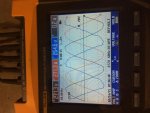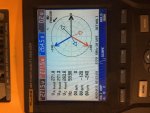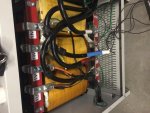kwired
Electron manager
- Location
- NE Nebraska
I have attached a pic of a open Y/open delta connection. I think this is happening between the 208 windings and the 3 leg common core. The other phase is being created by the 3 leg common core inducing into the 480V Y secondary. At first I thought this would not work because of the 30% phase shift from Y to delta, but when it goes back from delta to Y, I think it goes back in phase. Notice the primary side connection in the pic, with just 2 phases and the neutral. This is exactly what is there when one phase is disconnected on the grounded Y primary.
Any thoughts on this?
I am not seeing any relevance to the photo other then the primary is similar configuration to what you say you have with an open circuit in one of the input conductors. Otherwise you don't have a picture of a common core and the secondary as described in your OP is supposed to be wye connected and also on common core.:?
What you do have pictured there is a common arrangement for open delta secondary services from POCO's around here when transformer bank is made up of single phase transformers.
I think if you drew same thing with a third transformer and a wye secondary - loss of an input line would result in no voltage on the corresponding output phase, but if on a common core you may see some voltage output on the otherwise lost phase- but may not be at the correct phase angle or have any near the normal output ability.
Maybe the fact your inverter did not go off line is why you have correct phase angle? Or did you test this phase angle without the inverter connected?
Last edited:



